|
Ceremonial Time: Fact or Fiction?
An Inquiry into John Hanson
Mitchell
Littleton Massachusetts
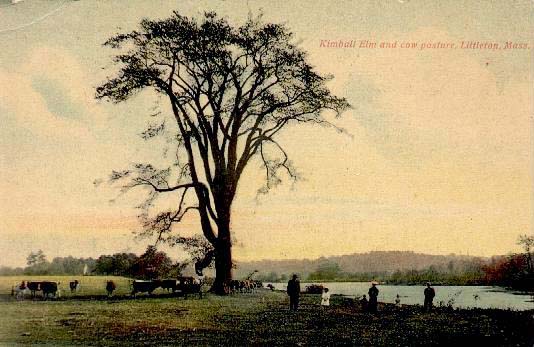
The Witch Tree
Field Investigation:
14 March 2005
by Daniel V. Boudillion
|
Setting the Record Straight on the Dudley Witch
Accusations of 1720 in Littleton
Introduction
As a Littleton native I have enjoyed the many books by
Littleton resident John Hansen Mitchell, especially
Ceremonial Time: Fifteen
Thousand Years On One Square Mile and
Trespassing: An Inquiry Into The
Private Ownership Of Land. These
are both marketed as works of nonfiction, and contain numerous historical accounts of
the town of Littleton Massachusetts and its inhabitants from times as early as the 1640's.
For the past several years I have been researching the
exact location of the lost 1675 Old Settler's Burial Ground on what used to be
the Powers Farm, then a part of Concord, but later annexed by Littleton in 1725.
This has required extensive research not limited to the Littleton Library, the
Littleton Historical Society, and the Cambridge Registry of Deeds; as well as
much field work by myself and my research partner.
Looking For Littleton's Witch
One day, growing tired of the chase, and unearthing in
the back of my file cabinet an old Littleton Independent newspaper article dated
Thursday, October 25, 1984 about Mary Louisa Dudley ("The White Witch of
Littleton"), I thought it might be a fun change of pace to find her grave.
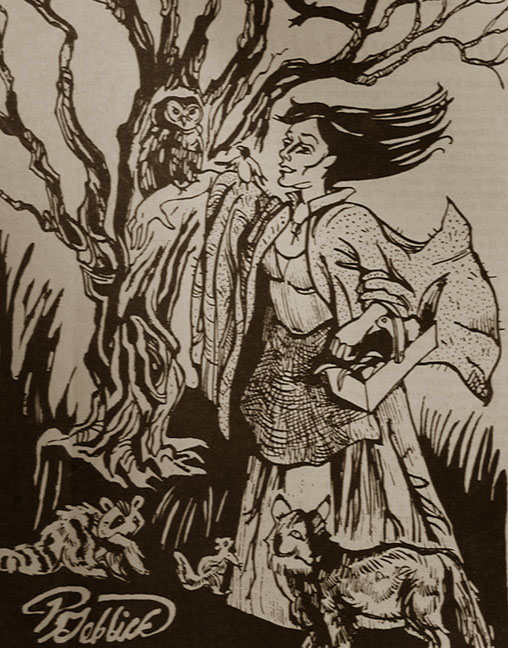
The White Witch of Littleton
Pamela Goblick - Littleton Independent - 25
October 1984
In doing so, I used my well honed historical research
skills, and immediately went looking for her birth, marriage, and death records
in the Littleton Town Record Book. Much to my surprise, I
was unable to find a Mary Louisa Dudley in the records. The newspaper
article cited John Mitchell as a source and I recalled that he had devoted a chapter of his book
Ceremonial Time to the
event, so I quickly got out my copy and began rereading it.
The only mention of her name was a reference in dialog
as Mary Louise Dudley, and again in the Cast of Characters forwarding the book.
Other than this it was simply Mrs. Dudley. However,
Mitchell did recount her husband's name as Thomas Dudley, so I returned to the
reference room in the Littleton Library armed with this new information.
Again to my surprise there was no mention of a Thomas
Dudley of that era in any of the town records. I began to wonder if the
incident was real at all, and resorted to
Harwood's Historical Sketch of
Littleton, and there on pages 866 to 877 of the Middlesex volume was his account
of Mrs. Dudley and the events. In short,
the account is as follows:
In 1720, Mrs. Dudley, the wife of Littleton's first
Town Clerk and Selectman, was being harassed by three young local girls -
sisters - who
would go into fits when she was around. This was exactly the practice of
the Parris girls in Salem Mass in 1692 who's behavior and accusations of
bewitchments instigated the Salem witch trials and eventual executions.
True to form, the three Littleton girls asserted that Mrs. Dudley was bewitching
them and was the cause of their apparent fits and predicaments as well.
No formal accusations were ever lodged, and the
Reverend Shattuck, Littleton's first minister, was skeptical and advised
separating the girls as a means of ending the shenanigans. This advice was
rejected by the parents, and in any event, Mrs. Dudley died shortly thereafter
after giving birth to her 13th child, Rogers Dudley. The girl's family
moved forthwith to Medford, and the eldest girl confessed to having made it all
up in 1728 to Medford's
minister, the Reverend Ebenezer Turell.
In studying Harwood's account, I was intrigued to note
that he gave Mr. Dudley's first name as Samuel. Going back to the town
records, it became apparent that Samuel was indeed the Dudley in question, and
that he had a wife Abigail who died in 1720, on the same day that the records
also show a son being born to them. Abigail was the actual name of the
Mrs. Dudley accused of witchcraft.
What the Heck?
It was clear there were fundamental discrepancies in
the newspaper account, and more disturbingly, in its source, the book Ceremonial Time by John Hanson Mitchell. The further I studied the
historical accounts and the town records that back them up, the more dismayed I
became as more and more inaccuracies piled up between Mitchell's book and the
actual facts. In fact, of the 17 or so facts of the events, he is dead
wrong on 16 of them. The only fact he got straight is that girls were
making their accusations in 1720's Littleton.
This is disturbing indeed, considering that Mitchell's
book Ceremonial Time is sold as nonfiction and is considered to contain
reliable historical accounts of Littleton. Before analyzing the meaning of
these inaccuracies, I will first present them, followed by the true historical
facts, with sources documented in all cases.
|
Flat Out Wrong: Mitchell
flubs 16 of his 17 facts
John Hanson Mitchell in Ceremonial Time
states:
"The events began, as these sort of things often did
in those times, with the odd behavior of two young girls..."
1. The facts:
There were three young girls.
1, 4,
5
John Hanson Mitchell in Ceremonial Time
states:
That their names were "Thankful and Virtue Pease..."
2. The facts:
Their names were Elizabeth, Joanna, and Mary.
1
3. The facts:
Their last name was not Pease, but Blanchard.
1, 4
John Hanson Mitchell in Ceremonial Time
states:
That they "...lived along the Great Road."
4. The facts:
They lived on Newtown Road in the Marshall place, on
what is now the Yapp farm. 1, 6c
John Hanson Mitchell in Ceremonial Time
states:
"Thankful Pease was about fourteen years old..."
"Virtue was two years younger..."
5. The facts:
Elizabeth was 11, Joanna was 9
1, 4, 5.
(Mary was 7. 10 )
John Hanson Mitchell in Ceremonial Time
states:
That "Virtue was two years younger and appears to be
something of a minor player in all this."
6. The facts:
Each girl in turn - Elisabeth, then Joanna, then Mary
- became fully involved. 1
John Hanson Mitchell in Ceremonial Time
states:
"On the east side of Beaver Brook, near the town,
there was a farm belonging to a certain Mr. Thomas Dudley..."
7. The facts:
The Dudley homestead was on the west side of Beaver
Brook. The house stood on the north shore of Mill
Pond (behind what is now Saint Anne's Church).
1, 6b
8. The facts:
Mr. Dudley's first name was not Thomas,
but Samuel. 1, 2, 7, 8, 9
John Hanson Mitchell in Ceremonial Time
states:
That Mr. Dudley had a wife "...identified in the
history books simply as Mrs. Dudley."
9. The facts:
Mr. Dudley's is identified as Abigail in
the Littleton Town Record book 8 times and in the Concord Town Record book 1
time. 2, 3
John Hanson Mitchell in Ceremonial Time
states:
That Mrs. Dudley was young: "Mr. Dudley ... had
a young wife" "...this young woman..."
10. The facts:
Mrs. Dudley was 37 in 1720 and had given
birth to 12 children, one by a previous marriage, and 11 children by Mr. Dudley,
and was pregnant at the time with a 13th child.
2, 7, 9
In hardscrabble 1720's frontier life, there is nothing "young" about being 37
years old with 13 children.
John Hanson Mitchell in Ceremonial Time
states:
That the accusing children's mother was named Arabella Pease: "The girls began to scream again, and once more Arabella
Pease went for the apparition."
11. The facts:
The girl's mother was named Elizabeth (Whittemore)
Blanchard. 4
John Hanson Mitchell in Ceremonial Time
states:
That Mrs. Dudley died of a miscarriage:
"... and died a few days later, apparently of a miscarriage.
12. The facts:
Mrs. Dudley died in childbirth.
The child, Rogers Dudley, lived. 2, 7
John Hanson Mitchell in Ceremonial Time states:
That Mrs. Dudley's name was Mary Louise: "Mary Louise
Dudley ... May or may not have lived as a witch on Scratch Flat [a section of
Littleton]."
13. The facts:
Mrs. Dudley's first name was Abigail.
She was born Abigail Rogers, she became Abigail King with her first marriage,
and became Abigail Dudley with her second marriage.
2, 3, 7, 9
John Hanson Mitchell in Ceremonial Time
states:
That Mrs. Dudley was born in 1700 and died in 1725:
"Mary Louise Dudley (1700 - 1725)" [And was thus 25 years
old.]
14. The facts:
Mrs. Dudley was born in 1683. She
married her first husband, Richard King, in Concord in 1699, who died three
years later. She married Samuel Dudley in 1704.
2, 7, 9
15. The facts:
Mrs. Dudley died on August 9, 1720.
2, 7 [37 years old.]
John Hanson Mitchell in Ceremonial Time states:
That Thankful Pease was: "by all descriptions, a
beautiful young country girl with clear green eyes and healthy skin."
16. The facts: There are no physical
descriptions of the girls to be found in any known historical account.
1, 2, 3, 4 ,5
Sources
1. Herbert Joseph Harwood: History
of Middlesex County, Massachusetts, Historical Sketch of Littleton (1890)
2. Records Littleton,
Massachusetts, Birth and Death 1711 - 1850
3. Concord, Massachusetts, Births,
Marriages, and Deaths 1635 - 1850
4. Samuel G. Drake:
Annals of Witchcraft in New England
(1869)
5. Rev. Ebenezer Turell of Medford:
Witchcraft
6. Maps: 6a. 1660, 6b. 1820, 6c. 1875, Littleton Historical
Society
7. Dudley Family Genealogy,
www.dudleygenealogy.com
8. Vital Records of Douglas Massachusetts
to 1849
9. Daniel Brainerd: Some Descendants of Daniel
King, Gentleman of Lynn, Mass.
10. Roger D. Joslyn: Vital Records of Charlestown
Massachusetts to 1850
|
Ceremonial Facts From "Ceremonial Time"
John Hanson Mitchell in Ceremonial Time
got every possible fact wrong, except for the year 1720. All the actual facts may
be found in Harwoods Historical Sketch of Littleton and the Littleton record
book
of Births, Deaths, and Marriages, with additional supporting documentation
elsewhere as shown in the Sources section. Both these resource books are in the
Littleton town library and the Littleton Historical Society and available for
the asking.
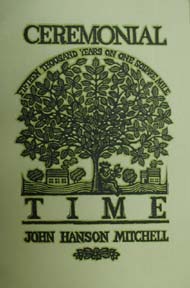
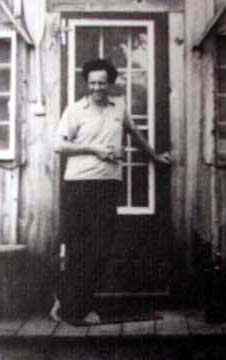
Ceremonial Time
Ceremonial Pose
by John Mitchell
John Mitchell
It is obvious that Mitchell had read
Harwood's account he has paraphrased sections of it almost word for word.
And yet he has used falsehoods rather than facts, even when it made no
difference to the "emotional impact" of the account as an entertaining story.
For example, Mitchell writes in 1984:
"The grownups would find the other girl floating in
the middle of a nearby pond or perched high in an apple tree, or on top of the
barn."
While in Harwood's original 1895 account:
"...she would be found in strange places, such as in
the top of a tree, or in a pond of water ... and was once found on top of the
barn..."
This and many other paraphrasings show that Mitchell
had indeed read Harwood's account. (Indeed, his entire account of the
children's doings and Mrs. Dudley's death is an embellished paraphrase of
Harwood.) Having obviously read Harwood's account, he would known at
a minimum the following facts:
That there were three
girls - not two.
That their names were
Elizabeth, Joanna, and Mary - not Thankful and Virtue.
That their last name was
Blanchard - not Pease.
That their ages were 11,
9, and 5 or 6 - not 14 and 12.
That Mr. Dudley's first
name was Samuel - not Thomas.
That the Dudley's lived
on the west side of Beaver Brook - not on the east.
That Mitchell knew these facts yet
related the account otherwise is very perplexing. Further, Mitchell goes
on to say in Ceremonial Time in regards to the Dudley story:
"Toby Beckwith, who related some of the finer details
of the story to me, after I dug them out from the town histories. . ."
This is further perplexing, as Mitchell is clearly
saying that he had dug the story out of the town histories (and therefore knew
the actual facts of the case), but seems to have opted against the facts for the
later embellishments of a man spinning tales more than 250 years after the
event.
It is always possible that Mitchell did not find
Harwood's telling of the tale riveting enough for a commercial book,
and added and changed a few details of the account for dramatic impact.
Changing the elder two girl's names from Elizabeth and Joanna to the pious
Christian names of Thankful and Virtue would be a good example of such a
literary device (though in nonfiction and historical accounts an absolute
no-no), if it is indeed the case. However, it does not account for the
apparently scrupulous changing and obfuscating of all the facts, especially such
dramatically unimportant ones as Mr. Dudley's first name, the girl's last names,
and the site of the Dudley homestead.
Rather, this painstaking obfuscation appears
meaningless and bizarre, especially in the case of changing the dramatically
unimportant facts - facts that Mitchell was fully cognizant with. Its not
like the real names, and all the facts, need to be changed to protect the
innocent - especially 250 years after the events took place.
Either way, we are left with the uncomfortable
conclusion that Mitchell arbitrarily changes factual history or invents it in his
historically-themed nonfiction books, partly for commercial ends, and partly it
appears, out of carelessness or indifference.
It also leaves one to wonder, when you consider that
he has 16 out of 17 facts wrong in one part of one chapter, what
kind of inaccuracies and inventions there may elsewhere be in his other
books. (For example, my research partner's work in the Cambridge Registry
of Deeds shows that the chain of title to the Littleton lands summarily
disproves the central dramatic point that he based his book Trespassing around.
Further, his account of the Mary Shepard abduction in
Walking Towards Walden is flat out wrong, as usual, in its facts.)
All we can say in the end is that the "facts" are
merely ceremonial appendages to Mitchell, to be changed, embellished, or
invented by him
for whatever arbitrary reasons, even in works sold as history-themed nonfiction.
One Amazing Sampler
Rather then use Mrs. Dudley's correct name Abigail,
the use of name Mary Louise as her name seems to have come from conversations between Mitchell and
an unnamed Littleton resident, as accounted in his book Ceremonial Time.
Mitchell relates in the book that the woman has a family sampler that was
inscribed Mary Louise Dudley, as follows:
"A few years after she moved to Scratch
Flat [a region of Littleton], after she had experienced the sense of replay, she
made an incredible discovery that finally gave a purpose to her life, or at
least to her presence in this time and place. She said that her mother had
given her a sampler with the family name inscribed on it along with a little
homily about farm life. The sampler had been given to her mother by her
mother, who had received it from her mother, and so on back into history.
My friend had carried the sampler with her and, knowing that she had ancestors
in New England, decided at one point, even though she was not overly interested
on genealogy, to see if she could trace her family. She happened to meet a
woman at her work who was interested in local history and knew how to find her
way through the maze of documents and birth records, and through her, she began
to track down the name sewn into the sampler.
"What was it?" I asked her.
"Mary Louise Dudley."
"You knew then?"
"I wasn't surprised. I knew.
Yes. Should have known."
"And you know the story of Mrs. Dudley?"
"I know that story, yes."
"And you believe she was a witch?"
"I can't say. I believe she was
different..."
In the off chance that the town's historical documents
and records were somehow incorrect, or that I had missed something, I took the
time to trace the Dudley genealogy of the woman in question, who I knew through
a mutual acquaintance.
I was able to locate several Mary Louise Dudley's, all
born between 1853 and 1927, and a Mary Louisa Dudley born in 1807, but no
records of such a name from the 1720's. Also, I was unable to find a
connection from any of these Mary Louise-Louisa Dudley's to the Littleton woman,
or a connection back to from them to the Samuel Dudley line. Nor was I
able to run a line back from the woman to Samuel Dudley. I would suspect
that the woman is descended from a different Dudley entirely, although that does
not explain why I could not find a Mary Louise-Louisa in her Dudley ancestry.
Perhaps another genealogist with more time and interest can clear up these small
mysteries.
Another doubt against the Mary Louise of the sampler
being the Mrs. Dudley of the 1720 events is the sampler itself. Were this
really Mrs. Dudley's in 1720, it would have been 264 years old at the time
Mitchell's book was published in 1984. Textiles are virtually non-existent
from that era for many reasons, not the least being the deterioration of the
fabric in a non-archival environment in that amount of time.
We are left to wonder a number of things about
Mitchell's inclusion of the sampler incident and the part it plays in the larger
dramatic circle of the Mrs. Dudley story. Again, it appears that facts
were changed and ignored, embellished and invented to meld the events of 1720 into a human
interest story of the present.
One hates to think that Mitchell knew that Mrs.
Dudley's real name was Abigail while letting his friend continue with the false
belief that it was Mary Louise (and therefore apparently a spiritual connection between the
friend and the Mrs. Dudley who was accused of witchcraft), and enshrining this
delusion for the ages in his book, simply to sell copy.
Nice Fellow, Enjoyable Books
Last year when I unexpectedly and unhappily uncovered
the endless flood of inaccuracies and falsehoods in but one part of one chapter
of John Hanson Mitchell's historically-themed nonfiction book Ceremonial Time,
I had the idea of writing a report to set the historical record straight.
I ran this by a well-known Littleton citizen. Although he
allowed that Mitchell "plays fast and loose with the facts," he was horrified by
my intentions and worried in the extreme that I would incur considerable wrath
and backlash for doing so. He put it simply, "People like John."
And that is true. Having met the man myself, and
having spent an afternoon on a walkabout with him in the Sara Doublet Forest in
Littleton, I can certainly agree that he is a likable person. And I have
also enjoyed his books over the years, looking forward to new releases, and
purchasing them as they are published. Indeed, it is an honor to the
town having a living author of note - who writes books on the towns history - as
a resident.
However, Facts are Facts...
...and Mitchell's works have
become part of Littleton's historical canon. They are far more accessible
than the historical records in the Littleton Library and the Littleton
Historical Society, some of which records are not allowed out of the buildings.
His books are far more easy to learn local history from because the stories are
written out, rather than having to piece them together from the historical
documents of the time. It is far easier to read Mitchell then to do the
work. The result is that readers take his accounts in good faith as fact,
and the popular history of the town is become more and more based on his skewed
stories, dramatic embellishments, and inaccuracies.
Indeed, the Littleton Library has even placed
Mitchell's book Ceremonial Time in the historical document/research room
under the Town History section - where it sits ready to mislead generations to
come.
Publishers Page, Inside Cover, Ceremonial Time:
ISBN 0-395-59129-5 (paper):
1. Littleton (Mass.: Town) - History. 2.
Wamesit Indians - History. 3. Indians of North America -
Massachusetts - Littleton (Town)-History.
For the record, the above Publishing and Title
information from the book Ceremonial Time states flatly that this book's
classification is history, and primarily Littleton town history.
The fact is that via Mitchell, much of the history of
Littleton is seeing the light of day for the first time in many many years - and
to the attention of a new generation of readers due to his efforts, which we are
all grateful for. Unfortunately, these efforts have not been factually
satisfactory, and the history recounted, particularly in the case presented
here, is dead wrong in 16 out of 17 facts. It is essentially a romanticized
and invented history presented to an unsuspecting readership - either out of an
eye to sales, or simple carelessness and indifference - none of which are
desirable traits in historical writing.
This report is published - wrath and backlash be
dammed - that the actual facts of the Dudley Witch episode in Littleton history be
made easily available for future generations and historians.
Teaching Fiction As Fact
 2007 Update:
I was recently contacted by a collage student who reported with no small anxiety
that Ceremonial Time was on the book list of one of his classes, and that
the professor was teaching the book as fact.
2007 Update:
I was recently contacted by a collage student who reported with no small anxiety
that Ceremonial Time was on the book list of one of his classes, and that
the professor was teaching the book as fact.
So there you have it - Mitchell's effed up history is
being taught as fact in collage.
Conclusion
We have a lot to thank John Hanson Mitchell for.
His books have brought Littleton history out of the historical document rooms of
the Littleton town library and the Littleton Historical Society, and placed it
in the hands of the reader at home, in a very engaging narrative style.
It is unfortunate that this effort and appreciation is marred by faulty
scholarship.
* * *
Note: The postcard in the header picture is the
Kimball Elm, which was known locally as the Witch Tree. It marked the
folk-memory location of the Samuel & Abigail Dudley homestead cellar hole on the shore of
Mill Pond behind Saint Anne's church. The tree is no longer standing.
Email Daniel V.
Boudillion
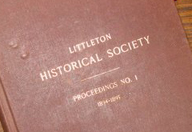
Back to Field
Journal
Copyright © 2005 by Daniel V. Boudillion
|




